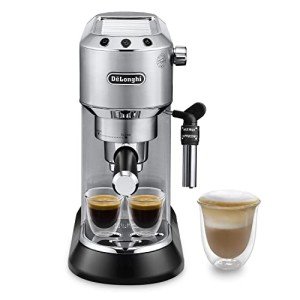Heat Exchange Espresso Machines: A Comprehensive Guide
Espresso machines have developed considerably for many years, dealing with the requirements of home baristas and coffee experts alike. Among these machines, heat exchange espresso machines have acquired appeal due to their capability to provide consistent performance and remarkable brew quality. In this post, we will explore the operations, benefits, and important features of heat exchange espresso machines, providing an extensive understanding for both possible buyers and coffee enthusiasts.
Comprehending Heat Exchange Technology
Heat exchange espresso machines operate on a special concept that allows simultaneous water heating for brewing and steaming. They are equipped with a single boiler that makes use of a heat exchanger system. This function is substantial as it allows users to brew espresso while steaming milk simultaneously, promoting effectiveness in the coffee-making process.
How Does a Heat Exchange Espresso Machine Work?
The procedure starts with the machine's water inlet filling the boiler. As the water warms up, it turns to steam. The innovative heat exchanger uses hot steam to heat extra water in a different passage designed particularly for the brew group. This suggests that water can reach the ideal developing temperature without awaiting the boiler to adjust. The essential steps include:
- Water Fill: Water is drawn into the boiler.
- Heating Process: The boiler warms up as water is converted into steam.
- Heat Exchange: Steam heats up water in the heat exchanger tube.
- Developing: Water from the heat exchanger is pushed through coffee grounds, extracting the flavors needed for an abundant espresso.
This process permits for quick temperature adjustments and enhanced coffee extraction.
Benefits of Heat Exchange Espresso Machines
Heat exchange espresso machines provide several advantages, particularly for those looking to maximize their coffee experience. Here are some essential benefits:
- Simultaneous Brewing and Steaming: Users can brew espresso while steaming milk, making it ideal for hectic cafes and home baristas who value effectiveness.
- Temperature Stability: The boiler's steam pressure helps keep a steady temperature level, which is crucial for constant espresso extraction.
- Adaptability: The design enables fast switching in between brewing and steaming, making it easier to develop different coffee drinks, from lattes to coffees.
- Easy to use: Models frequently feature available controls, making it feasible for both newbies and knowledgeable baristas to produce quality beverages.
- Professional Quality: Heat exchange machines are often utilized in commercial settings, supplying users with high-quality developing performance at home.
Key Features to Look for in Heat Exchange Espresso Machines
When considering the purchase of a heat exchange espresso machine, there are several functions that a person must consider:
- Build Quality: Look for machines made from long lasting products, such as stainless steel or brass, making sure durability.
- Boiler Size: A larger boiler will hold more water and sustain higher output in time.
- PID Temperature Control: This function assists maintain constant brew temperatures, which can improve the coffee-making process.
- Group Head Design: Machines with a saturated or semi-saturated group head provide much better temperature level stability.
- Ease of Use: User-friendly user interfaces and intuitive controls improve the total experience for baristas at all skill levels.
- Steam Wand Quality: A good steam wand with proper insulation and flexibility enables for much better texturing of milk.
- Water Reservoir Size: Depending on your requirements, consider how often you wish to fill up the water tank.
Comparison of Popular Heat Exchange Espresso Machines
To better comprehend the choices offered in the market, listed below is a contrast table of some popular heat exchange espresso machines:
| Machine Model | Boiler Size | PID Control | Cost Range | User Ratings |
|---|---|---|---|---|
| Profitec Pro 700 | 2.0 L | Yes | ₤ 2,000-₤ 2,500 | 9.5/ 10 |
| Rocket Espresso R58 | 1.8 L | Yes | ₤ 2,400-₤ 2,800 | 9.4/ 10 |
| Elekta Bianca | 1.8 L | Yes | ₤ 2,500-₤ 3,000 | 9.6/ 10 |
| La Spaziale S1 Vivaldi II | 1.5 L | Yes | ₤ 1,800-₤ 2,200 | 9.2/ 10 |
| Bezzera Magica | 1.2 L | No | ₤ 1,600-₤ 1,800 | 9.0/ 10 |
Frequently Asked Questions About Heat Exchange Espresso Machines
What is the primary difference in between a heat exchange and a dual boiler espresso machine?
While both types can brew espresso and steam milk at the same time, dual boiler machines have separate boilers for developing and steaming. On the other hand, heat exchange machines make use of a single boiler and a heat exchanger to accomplish the exact same function.
Are heat exchange machines suitable for novices?
Yes! Many heat exchange machines are designed with easy to use features, making them available for novices. With appropriate guidance and practice, users can quickly produce quality espresso.
What kind of upkeep do heat exchange espresso machines need?
Routine upkeep consists of descaling, cleaning the boiler, inspecting seals and gaskets, and keeping the group head tidy. Regular upkeep makes sure durability and consistent performance.
Can I use a heat exchange machine for various kinds of coffee beverages?
Absolutely! Heat exchange machines allow users to create a variety of coffee drinks, including espresso, lattes, cappuccinos, and more.
Heat exchange espresso machines represent a mix of development and tradition, offering coffee lovers with the tools needed for crafting the perfect cup. Their ability to all at once brew and steam, combined with precise temperature level control, makes them an engaging option for both home baristas and experts. With Italian Espresso Machines on features and maintenance, users can unlock a world of exquisite coffee experiences, ensuring that each sip is as delightful as the last.

